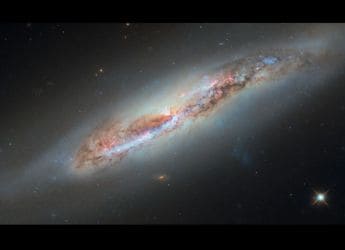- Home
- Science
- Science News
- Study Throws Light on Milky Way's Most Recent Major Collision
Study Throws Light on Milky Way's Most Recent Major Collision
Researchers say their study accounts for almost the entire growth of the Milky Way over the past 10 billion years.

Photo Credit: Instagram/ NASA
One of the most interesting puzzles of the universe is how galaxies evolve
Our galaxy, the Milky Way, houses the Solar System and its varied mysteries. But there are hundreds of galaxies like ours in the cosmos and all of them are hiding multiple enigmas. They arouse acute interest among scientists, who are drawn towards them because of these puzzles. One of the most interesting puzzles is how galaxies evolve. The galaxies follow a particular pattern with other systems. At present, one of our nearby neighbours, the Sagittarius dwarf galaxy, is being tidally disrupted. Two others, the Large and Small Magellanic Clouds, are falling towards us.
However, these dwarfs are unlikely to merge with, say, Andromeda, our nearest large neighbouring galaxy, for another five billion years. Andromeda is about 10 times farther away from these dwarfs.
Scientists from the Harvard-Smithsonian Centre for Astrophysics (CfA) have detailed these and the last major merger of the Milky Way in a recent paper published in The Astrophysical Journal. They used data from the Gaia spacecraft, which was launched in 2013, and combined it with a new survey of the outer Milky Way to piece together the history of our galaxy's stars and its last merger.
They found that a single dwarf galaxy merged with the Milky Way about 8-10 billion years ago. They named the remains of the dwarf Gaia-Sausage-Enceladus (GSE). But the scientists were uncertain whether GSE collided with our galaxy head-on or whether it orbited the galaxy before gradually merging. Their research showed GSE contained about half a billion stars and it did not orbit the Milky Way. The GSE approached our galaxy moving in a retrograde direction (opposite to the Galaxy's rotational motion). The scientists also think that some of the Milky Way's stars, which are about 13 billion years old, may have been captured by it after its formation.
The researchers say their study accounts for almost the entire growth of the Milky Way over the past 10 billion years.
Get your daily dose of tech news, reviews, and insights, in under 80 characters on Gadgets 360 Turbo. Connect with fellow tech lovers on our Forum. Follow us on X, Facebook, WhatsApp, Threads and Google News for instant updates. Catch all the action on our YouTube channel.
Related Stories
- Samsung Galaxy Unpacked 2025
- ChatGPT
- Redmi Note 14 Pro+
- iPhone 16
- Apple Vision Pro
- Oneplus 12
- OnePlus Nord CE 3 Lite 5G
- iPhone 13
- Xiaomi 14 Pro
- Oppo Find N3
- Tecno Spark Go (2023)
- Realme V30
- Best Phones Under 25000
- Samsung Galaxy S24 Series
- Cryptocurrency
- iQoo 12
- Samsung Galaxy S24 Ultra
- Giottus
- Samsung Galaxy Z Flip 5
- Apple 'Scary Fast'
- Housefull 5
- GoPro Hero 12 Black Review
- Invincible Season 2
- JioGlass
- HD Ready TV
- Laptop Under 50000
- Smartwatch Under 10000
- Latest Mobile Phones
- Compare Phones
- OnePlus 15R
- Realme Narzo 90x 5G
- Realme Narzo 90 5G
- Vivo S50 Pro Mini
- Vivo S50
- OPPO Reno 15c
- Redmi Note 15 5G
- Redmi Note 15 Pro 5G
- Asus ProArt P16
- MacBook Pro 14-inch (M5, 2025)
- Infinix Xpad Edge
- OnePlus Pad Go 2
- OnePlus Watch Lite
- Just Corseca Skywatch Pro
- Acerpure Nitro Z Series 100-inch QLED TV
- Samsung 43 Inch LED Ultra HD (4K) Smart TV (UA43UE81AFULXL)
- Asus ROG Ally
- Nintendo Switch Lite
- Haier 1.6 Ton 5 Star Inverter Split AC (HSU19G-MZAID5BN-INV)
- Haier 1.6 Ton 5 Star Inverter Split AC (HSU19G-MZAIM5BN-INV)

















